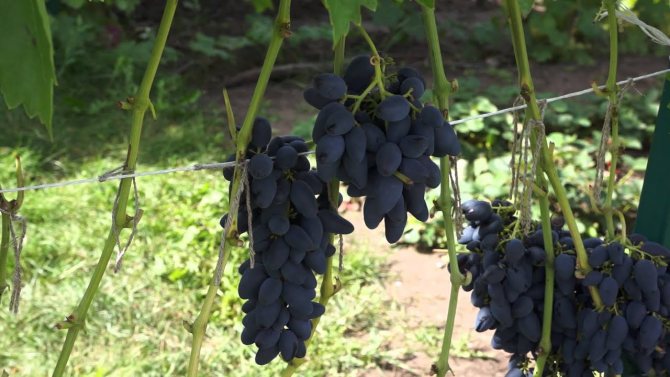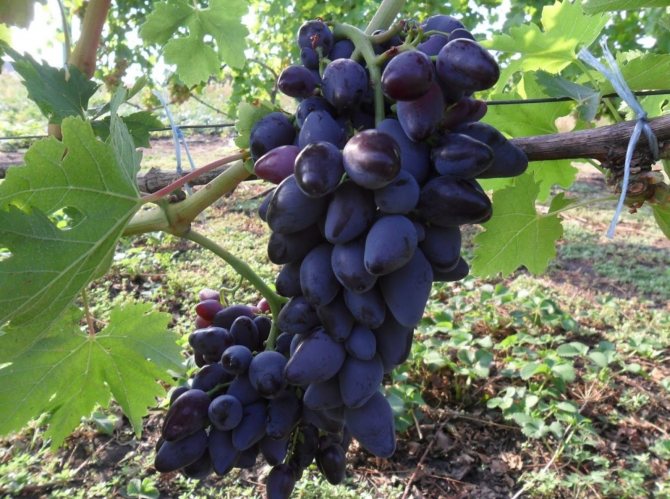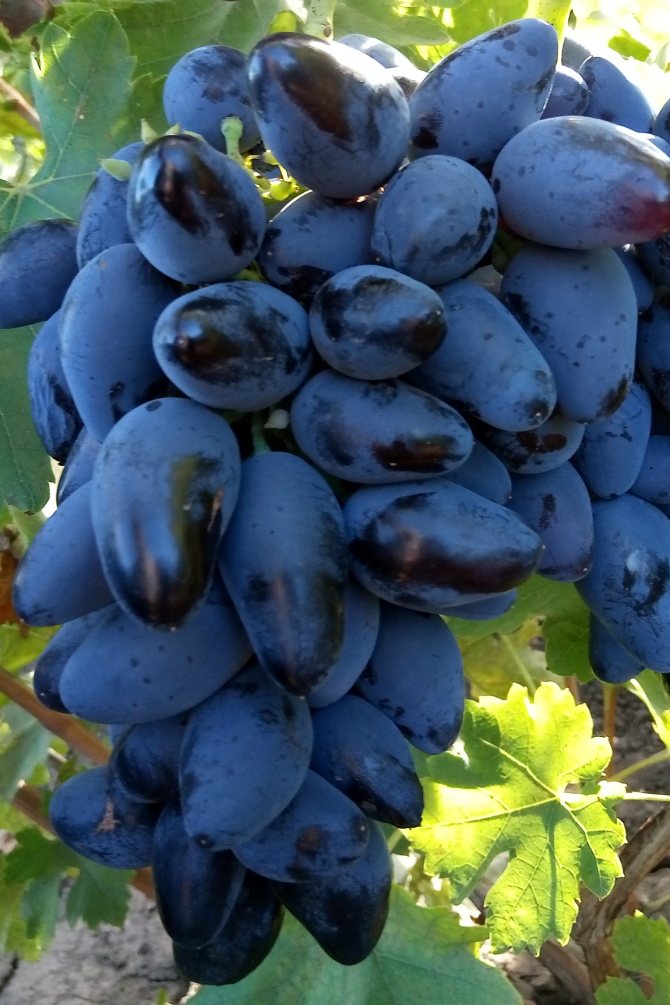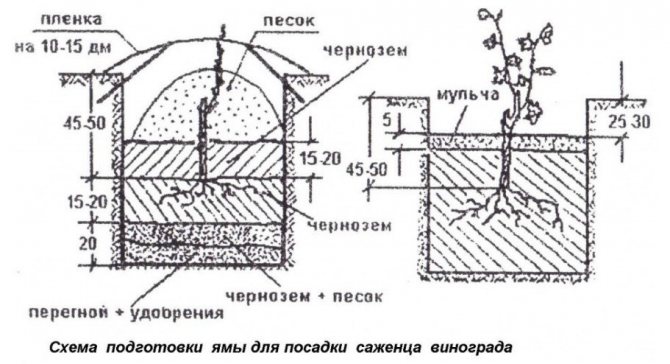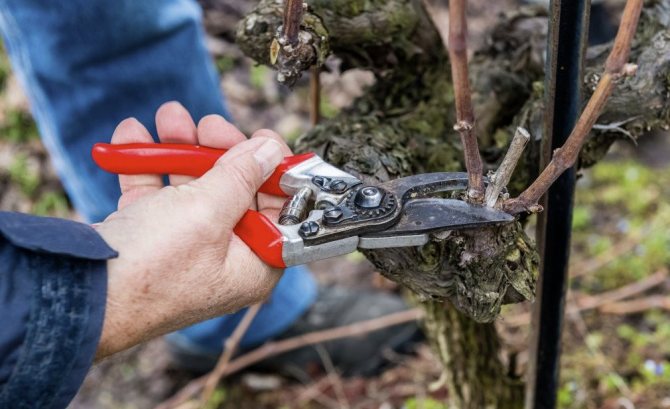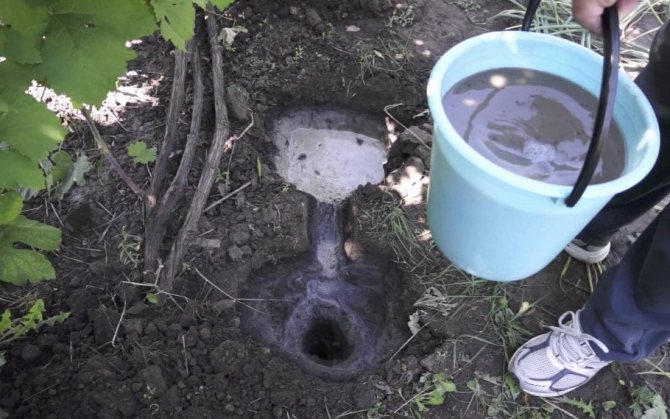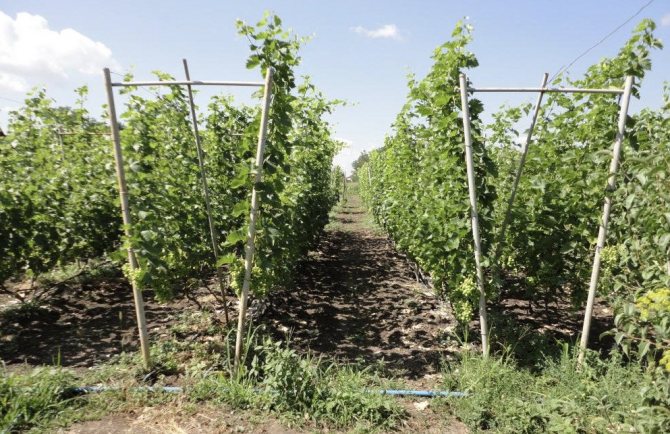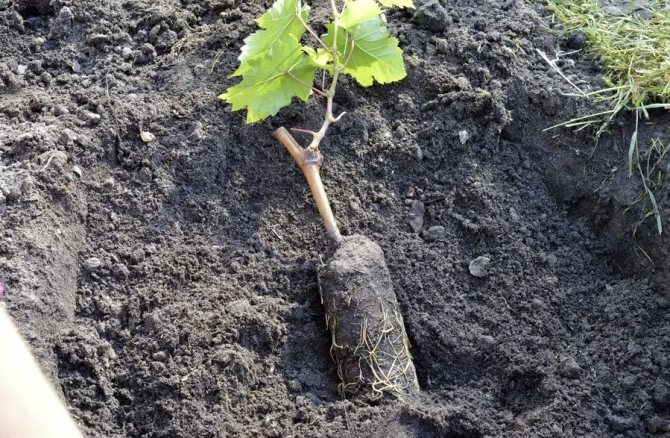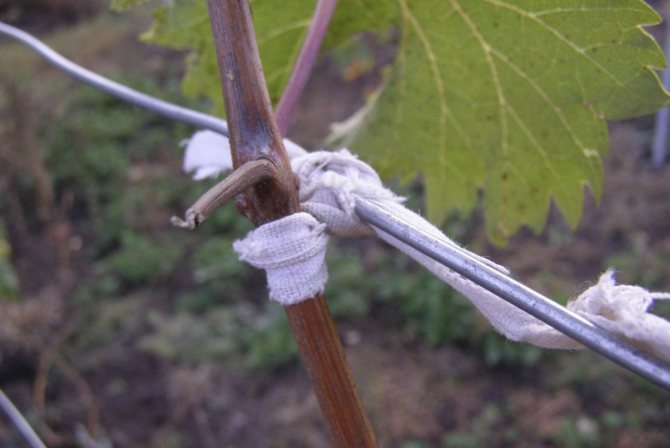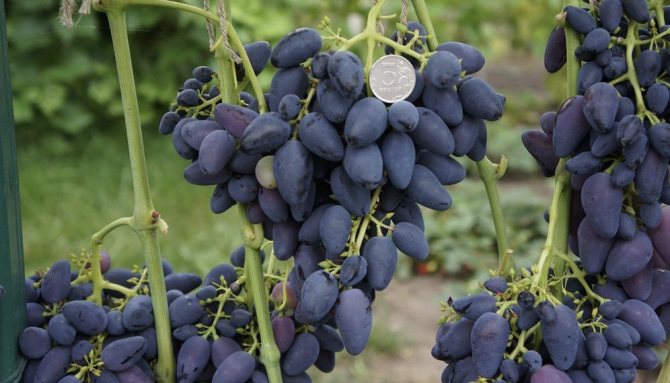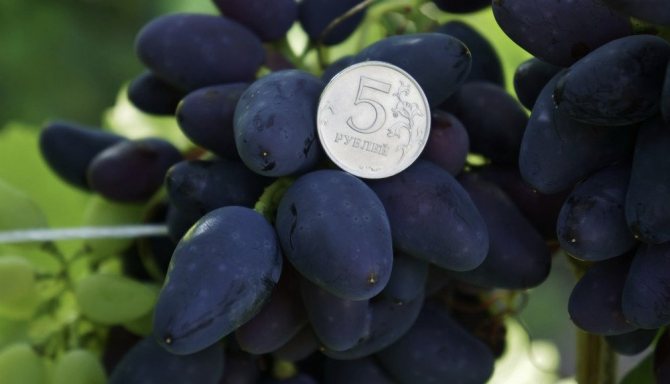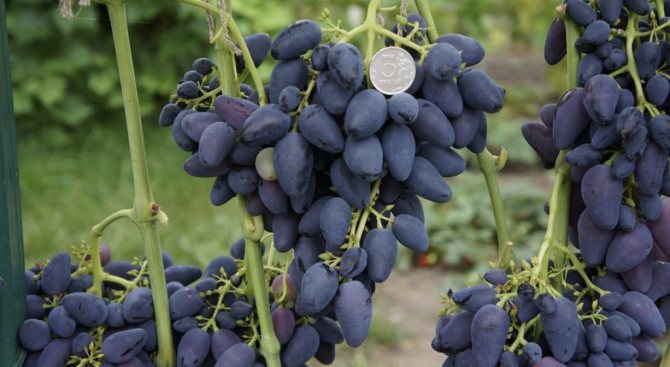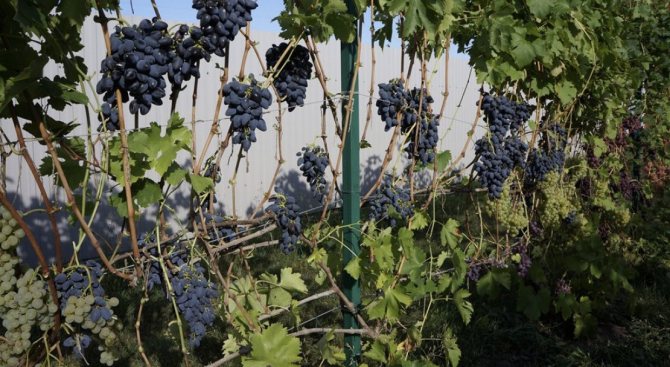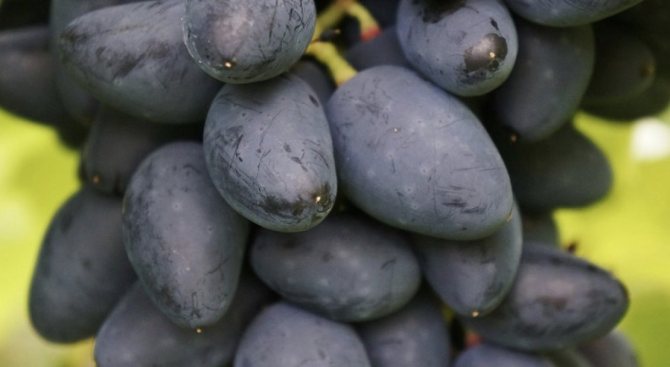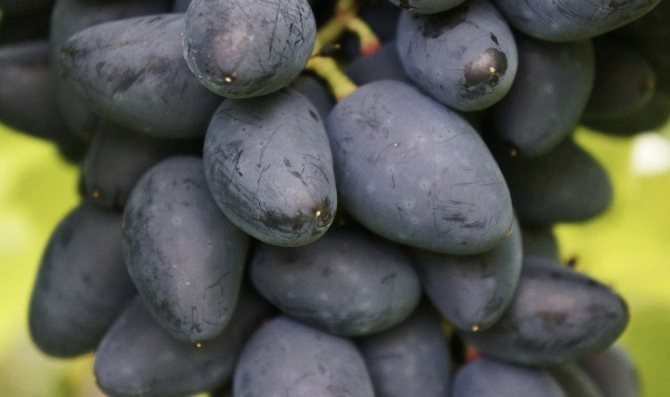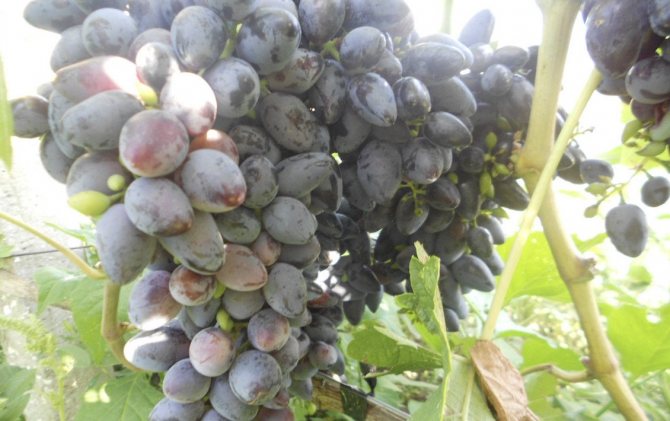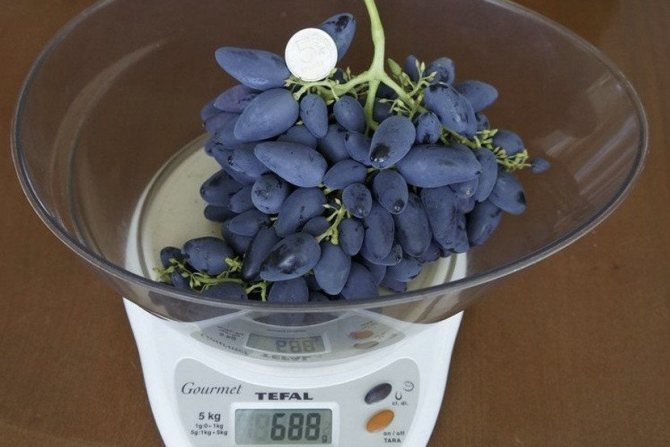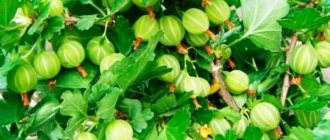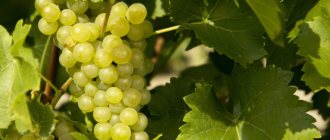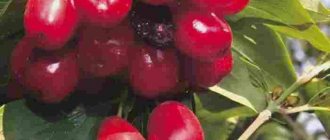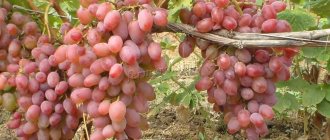Viking variety (grapes): description, cultivation, reviews
Nowadays, breeders have bred a huge number of different types of garden plants. The Viking grape variety is very popular. He has earned a lot of praise and positive reviews from those people who are already familiar with these delicious fruits. In this article, we will talk about how to grow Viking (grapes), how to care for it, get acquainted with the description of the plant and find out how grape connoisseurs speak of the variety. The information will be useful to those who decided to plant a grape bush on their site, but have not yet decided on the choice.
Viking grapes: description
Viking is a table-hybrid form of grapes, it belongs to the very early varieties. The ripening period of berries is 100-105 days, the shoots in the process of growing also ripen completely quite early.
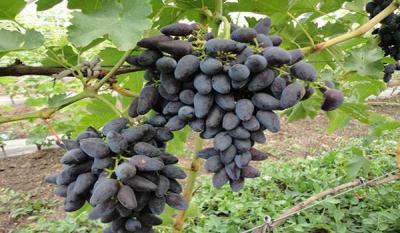
The plant has strong, strong branches, the flower is of two sexes. The grape clusters are cone-shaped, beautiful and large.
The berries are dark blue, medium-friable, with a size of 22 x 34 mm. Brushes can weigh 500-900 grams. The taste is wonderful, the pulp is firm and at the same time very juicy. Fruits can persist on the vine for a very long time, sometimes until the very end of September. During transportation, the presentation is preserved, the berries can withstand transportation over long distances.
The leaves are large, five-lobed with an open petiole.
Viking (grape) has good frost resistance, can withstand temperatures up to 21 degrees below zero.
What is the best way to let the vine
Viking bushes are distinguished by their powerful growth force. It is best to grow it on some kind of arches. The Viking grape bush is quite massive, so it can be launched on a gazebo. It looks very beautiful on arches, but trellises remain the surest way to grow it, where it ripens much better, especially if it is grown in the northern regions.
The grape has large five-pointed leaves. Ripening of shoots occurs early and violently. The flower is bisexual. Therefore, it is not necessary for him to have another grape bush nearby for pollination. Early ripening of the vine.
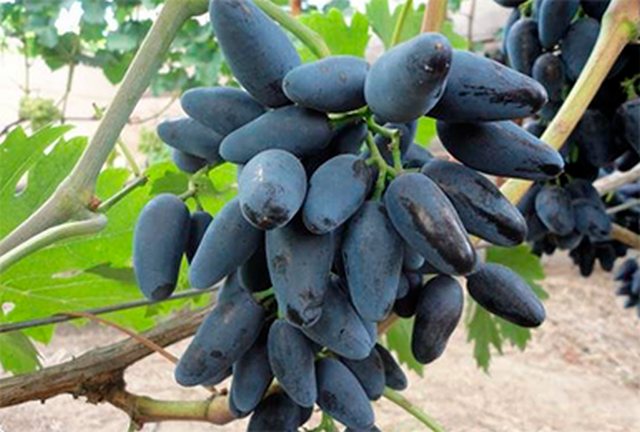

This grape variety is not the most frost-resistant, so it is advisable to cover it for the winter. This grape ripens in about 110 days and is very disease resistant. Diseases like Dion or others hardly affect him. The Viking variety has unlimited growth, so it is better to leave more space for it in the garden or in the garden. He loves space.
The hybrid form of grapes is very inconvenient to care for. At the time of ripening, it is rather inconvenient to spray, mint and water a bush with a ripening stepchild's harvest.
What Viking grapes don't like:
- Viking grapes do not like excessive moisture. Too abundant watering can harm him due to cracking of the berries. Berries crack exactly when the climate is humid and with excessive watering.
- An excess of nitrogen fertilizers leads to overgrowth of grape leaves, which reduces fruiting and makes it vulnerable to fungal diseases.
Growing and care
Viking is great for growing in the country. Choosing a place for a new "inhabitant" of the garden, you need to opt for the southern or southwestern territories with soft soil that warms up easily.It is unacceptable to plant the vineyard in swampy areas and clay soils. The ideal place for the plant will be one that is protected from cold winds and where snow melts quickly in spring.


Before planting seedlings, you need to pay attention to where the groundwater passes. If the water is close to the surface, then you need to fill up the earth one and a half meters.
The Viking grape variety does not need any special care, but there are still some rules. The plant does not like abundant watering, especially this should be monitored, starting at the end of July. It is necessary to apply fertilizers, loosen the soil in time and cut off the stepsons.
Young bushes should not be opened immediately after the end of winter, as they have not yet gained strength and may suffer from even minor frosts. If you follow all the recommendations for care, then the harvest of delicious grapes will be ensured.
Diseases
Viking grapes are extremely susceptible to fungal diseases. The prevention of oidium and mildew begins in early spring. Any antifungal medication is suitable for this. The second antifungal treatment of the vines is carried out before flowering. The third treatment is carried out when the crop has already been harvested and the plant is preparing for wintering. For the last treatment, you can use Bordeaux fluid.
Viking is a delicious grape that will decorate the table and fill the body with valuable vitamins. It is enough to provide him with proper care and protection from diseases, and then the harvest will not be long in coming.
Planting seedlings
Viking (grape) is able to bear fruit for many years if the bushes are planted as needed. The distance between seedlings should be 1-1.25 meters, this distance cannot be changed to more or less. The roots and shoots on the planting material are checked before planting so that there is no damage.
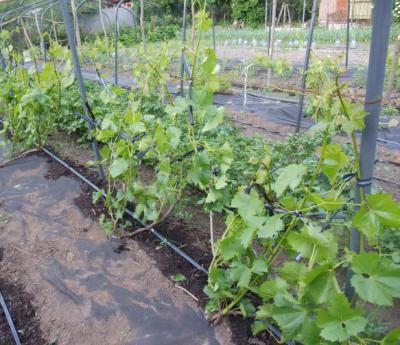

A suitable material is cut into 2-3 buds and the tops of the shoots are placed in paraffin, garden varnish or wax. Pour humus into the planting pit. Before being placed in a prepared hole, the roots are dipped in a special mixture. It is prepared from clay, water and rotted mullein mixed to the consistency of sour cream. After that, the grapes are lowered into a hole, covered with soil and thoroughly tamped the earth around the plant. After that, watering with warm water is necessary.
After planting grape bushes, you need to remove excess shoots in time, leaving only 2-3 shoots.
Seed preparation
Sowing for growing seedlings begins in late February - early March. Pre-check the germination by immersion in a salt solution (1 tablespoon of salt per glass of water). If the seeds float, they should be removed. The probability of their germination is very low.
Then the selected seeds are kept in a 2% solution of potassium permanganate (for half a glass of water, 2 g KMn04) for the purpose of dressing for 20-30 minutes. At the end of the disinfection procedure, it is necessary to rinse the seeds with clean water.
Additional pre-planting soaking in phytopreparations ("Kemir", "Epins-extra") enhances germination. For this purpose, squeezed aloe juice is suitable. The seeds are kept for 12-24 hours at room temperature until the shell swells and softens under the influence of moisture. Then they are placed in gauze soaked in water and kept warm until germination begins.
Viking grapes: reviews
To learn more about the positive qualities of this plant, we turn to the generalized reviews of experienced gardeners:


- Viking (grape) lives up to its excellent reputation: already with the first harvest, it gives 6 large clusters of juicy berries. The variety is ideal for the "market" category. By the beginning of August, the fruits fully ripen and go on sale.
- The berries are very beautiful, they are not subject to peas, the taste is at the highest level.
- Viking grapes have a crisp, good balance of acidity and sugar content. There are notes of prunes, ripe cherries and grapes;
- Pollination is excellent. It bears fruit well for many years.
Not a single person speaks badly about this wonderful grape, it deserves such praise and is able to take far from the last place in the list of the best early varieties.
Read also: How to plant carrots in granules in open ground: a step-by-step video instruction
Viking grapes: variety description
Bunches of Viking grapes yield medium size and medium density. The shape of the brushes is conical or cylindro-conical, weight - 500 - 750 g. Occasionally there are specimens weighing 1 kg. The berries of the culture are deep purple, their shape is oblong, like that of an egg. The weight of 1 fruit is 8 - 12 g. Juicy sweet and sour pulp is hidden under the thin skin, which leaves an aftertaste of cherry and plum.
The fruit can maintain a normal appearance on the vine until the end of September. The marketability of the harvested crop also lasts a long time, so it can be transported over considerable distances.
The flowers of the Viking variety are bisexual. Leaves - large, 5-lobed with an open petiole notch. Young shoots ripen early and form multiple stepchildren. The hybrid is well pollinated in cool conditions.
The main characteristics of the hybrid
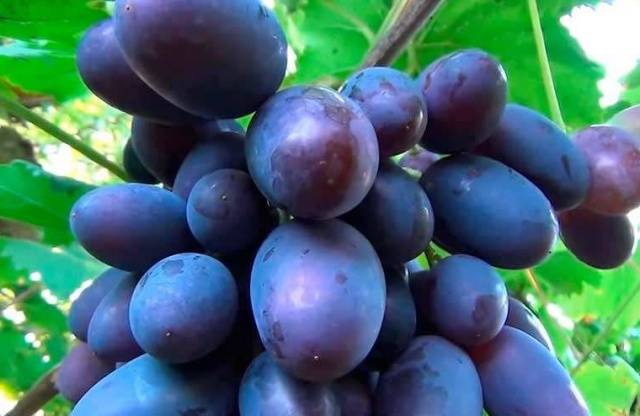

A feature of Viking grapes is the early ripening of bunches, which is typical for many hybrids. About 100 days after bud break, the first ripe berries will appear. Harvesting time falls in the first decade of August.
Grape seedlings are characterized by fast survival rate. Having adapted after planting, the vine begins to grow intensively, forming a spreading bush. Pollination of the hybrid occurs quickly due to the bisexual flowers. Viking is suitable as a pollinator for nearby growing unisexual plants.
The frost resistance of grapes is average. The vine is able to withstand temperatures as low as –21 ° C. It is difficult to grow Viking in the northern regions. It is easier for the vine growers of the Moscow region to do this, but for the winter the vine will have to be well covered. In addition to the bush itself, it is important to keep the fruit buds of the grapes from freezing. Otherwise, you will have to forget about a good harvest of berries. Optimal weather conditions for Viking in the south. Vine growers do not cover the vine in warm regions.
Important! The Viking hybrid does not react well to temperature fluctuations, and especially does not like heat. The fluctuations disrupt the pollination process. The brushes are small with small berries.


Considering the description of the variety, photo, Viking grapes, it is worth touching on the topic of watering. The hybrid does not respond well to high humidity. From frequent watering, rains, with a close location of groundwater, the berries in bunches begin to crack. At high humidity and temperature, there is a threat of fungus damage to the grapes. If such weather conditions are observed, it is necessary to immediately carry out preventive spraying of the vine with anti-rot preparations.
Viking bunches are conical in shape. The berries are large, densely packed. The mass of one bunch is from 0.6 to 1 kg. Despite these characteristics, the hybrid does not differ in high yield. The dense flesh is covered with a tough skin that protects the berries from wasps and other pests. However, when grapes are eaten, it is practically not felt. At the stage of technical maturity, the berries turn purple. A fully ripe bunch of grapes in the sun shows a dark blue color.
The popularity of the Viking is given by the taste of berries. The sweet-sour pulp is filled with a fruity aroma with a predominance of plums. With moderate watering of the hybrid, a good presentation of the berries is observed. The grape harvest can be used commercially. Berries from bunches do not crumble during transportation, as well as when hanging on the vine for a long time.
Important! The ripe pulp of berries contains 17% sugar. The acidity index is 5 g / l.
How to plant Viking grapes
A feature of the Viking variety is its long-term fruiting property. However, the hybrid will delight with the harvest for as long as possible only if the shrubs are correctly planted. When placing seedlings, it is necessary to leave a distance of 100 - 125 cm between them. This interval should not be greater or less.
Before immersion in the soil, the root system and shoots of plants are carefully examined for the absence of damaged areas. Dead roots or shoots are carefully removed. The adjusted planting material is cut into 2 - 3 buds and the top is placed in a garden pitch, paraffin or wax.
Planting holes are dug ahead of time and sprinkled with humus. Immediately before planting, the roots of the plants are kept in a mixture of clay, rotted cow dung and water (the components are stirred to a creamy consistency). Next, the grapes are dipped into the hole with their roots, fill the hole with soil and tamp the earthen surface around the seedling. Finish the work by watering the bush with warm water and hilling from the top.
When the grapes grow, the growing season is controlled. Shoots on the vine are removed every time, as soon as their number exceeds 2 - 3 units.
The planting time for Viking grapes depends on the climatic characteristics of the region. You can plant young growth from the second half of April until the end of spring. Planting too early or too late may be ineffective, because with a short growing season, the plant does not have time to take root and dies. In autumn, Viking grapes are not planted in central Russia.
Susceptibility to disease
Viking grapes have medium resistance to diseases such as mildew and powdery mildew.
Mildew and powdery mildew are fungal diseases, to prevent them, first of all, preventive measures are needed:
- collecting and burning affected leaves;
- autumn digging of land between rows;
- ensuring good ventilation of plants - planting plants at sufficient intervals from each other, timely pruning.
Fungal diseases of plants account for more than 80% of all diseases of agricultural crops.
Mildew or downy mildew is one of the most dangerous fungal diseases of grapes. The disease is caused by a fungus that hibernates directly on withered leaves and tolerates frost well. The onset of the disease can be seen by oily stains and white bloom on the leaves. At the next stage, yellow spots appear, leaf necrosis. The whitish fluff spreads to the inflorescences and can lead to a large loss of yield.
Photo Gallery: Signs of Mildew Disease


White spots appear on the surface of the leaf


The spread of white bloom on inflorescences and ovaries
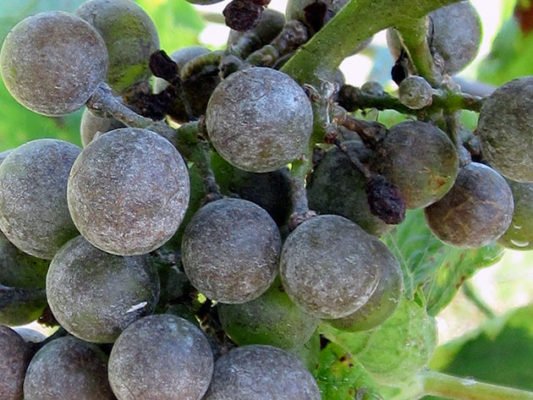

Mildew damage affects the quality of berries
If whitish fluff has already appeared on the leaves or the grapes have already been affected by mildew in the previous season, you cannot do without chemicals. Such drugs as Radomil, Delan, Thanos, Profit show high efficiency. Young plantings in the spring need to be sprayed about every 10 days, and from mid-June every week. When processing, use the dosage of the drug indicated by the manufacturer.
Oidium, or powdery mildew, is the most common grape disease. Unlike mildew, the spores of the fungus hibernate under the scales of the eyes and on the shoots themselves; at temperatures above 180, the spores begin to actively germinate and affect all parts of the plant. In early summer, infected buds and leaves turn yellow, a gray powdery coating appears. Subsequently, the leaves become covered with brown spots and gradually die off, the disease passes to the berries, which are also covered with plaque.
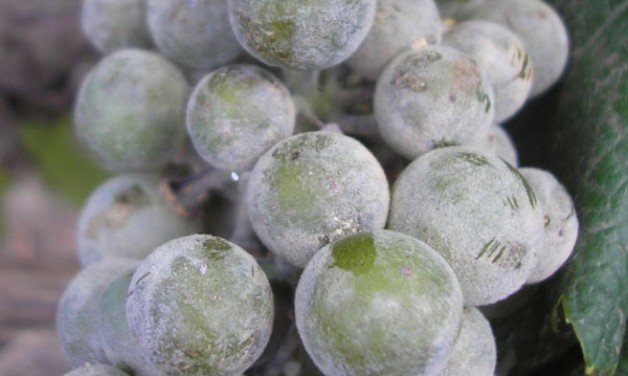

Typical powdery coating in case of grape mildew disease
To treat the vineyard from this disease must be started before bud break.During this period, it is necessary to spray with sulfur (dissolve 25–40 g of sulfur in 10 liters of water). After flowering, you can use drugs such as Rubigan, Topaz, Skor, Bayleton, Karatan, following the recommendations of the manufacturers of these drugs, indicated in the instructions.
Video: processing grapes from oidium, mildew
Growing and care
Initially, young Viking grape bushes require increased attention and scrupulous care. A separate item in the care is the fertilization of the hybrid.
If the nursery is set up in the northern regions, the land there is low in nutrients. Soils in the cold regions of the country are dominated by sandy and clayey. It is best to fertilize Viking grapes with manure harvested in the fall.
Effective fertilizers for the plantation will also be:
- Peat;
- Compost;
- Bird droppings;
- Wood ash.
Bushes growing on poor soils need feeding with microelements and organic substances.
The culture does not like abundant watering. Excess moisture is especially unacceptable in the second half of summer.
How many times to water Viking grapes:
- The first time the grapes are watered after the dry garter of the shoots;
- The plantation is re-moistened after pruning the vine, which does not have sap flow on the cut. If the sap is released even in a minimal amount, it is not recommended to water the plant;
- The third time the culture is watered when the length of the shoots reaches 30 cm;
- The fourth time is when grapes are in bloom;
- Fifth - when clusters are formed;
- The last watering is carried out after harvest.
Read also: Tomato Bobkat: reviews, photos, yield, description and characteristics
Viking grapes are cut in the fall so that the bushes are easier to cover for the winter. When pruning young, 3 to 8 fruiting shoots are left. All unnecessary is removed. Old bushes are shaped so that long shoots remain. The work is carried out at the beginning of the growing season, shortening the vine by 12 - 20 buds. The activity protects the bushes from overgrowing and pea fruit.
Pruning features
Viking grape bushes are formed into 3–8 arms. It is recommended to prune the fruit vine for 15 or 24 buds. Their minimum number can be from 12 to 14. When performing rationing, one should take into account the rather frequent underload of the bushes. You can safely leave a couple of inflorescences to escape. It is advisable to perform fan-shaped bushes, or cordon. Formation of arched vines is allowed.
You may also be interested in the article in which we talk about the varietal characteristics of the Veles grapes.

